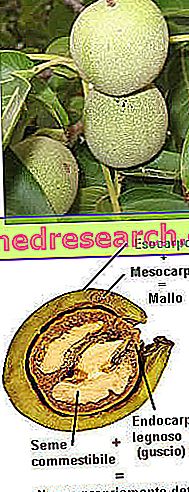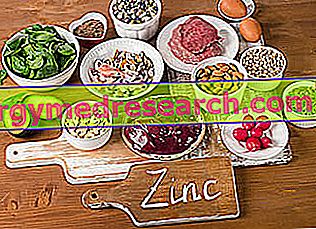Generality
Nocino is a liqueur made from the infusion of the husk of common walnuts (fruits of the Juglans regia L. plant) in ethyl alcohol.
The husk is the fleshy portion of the drupe (fruit), under which the real walnut is housed, consisting of the woody endocarp (shell) to protect the seed (the kernel or the edible part).

Nocino regulation, taken from the text: Food Law - by Gennaro Calì (1st edition) - pag. 549.
the nocino is the liqueur that is mainly flavored by the maceration and / or distillation of whole green walnuts (fruit of the Juglans regia plant, Linnea classification), having a sugar content of not less than 100g / l, expressed in invert sugar. The minimum alcohol-metric volumetric title of the nocino is 30% Vol. Nocino is subject to the rules set out in category 32 for liqueurs in relation to flavoring substances and aromatic preparations. The sales denomination can be completed with the term liquor.
Nocino is NOT a drink to be consumed freely and its alcoholic unit is clearly much lower than that of wine and beer.
Background
The origins of the nocino are rather uncertain, since the liqueurs based on walnuts have been consumed since ancient times in most of the old continent (excluding African territories).
It is however conceivable that the origin of the nocino is closely related to the history of British or French liqueurs. To be precise, according to the most quoted hypothesis, the nocino would have "bypassed" the Maritime Alps to descend to the Po valley, rooting itself first in the Savona area (in Liguria) and then in the Modena area (in Emilia Romagna); not by chance, the Emilian nocino is absolutely among the most delicious, even if the liqueur tradition involves several hilly provinces of the Italian peninsula (islands and Southern Italy included).
Nocino has been considered a sort of "magic drink" since ancient times. Its production should in fact respect a very precise rite, which involves the hand-harvesting of unripe fruits on the night between June 23 and 24 (San Giovanni Battista); the operation should be carried out by a very experienced woman (vaguely reminiscent of a witch's profile) and needs to rest the nuts on the ground until the following morning. On the following day, walnuts should be engraved with NON-metallic instruments and infused for about 17 weeks, or until October 31st (Saint's Day).
Preparation
The formula that follows will be taken from the web page of the Order of the Nocino Modenese (Medieval Tower C.so Umberto I Spilamberto - Mo); however, to get a precise idea of the nocino preparation, I suggest to consult Alice's videorecetta on the page: Nocino - Liqueur with Nuts.
Nocino - Homemade Liqueur with Nuts
X Problems with video playback? Reload from YouTube Go to Video Page Go to Video Recipes Section Watch the video on youtubeRecipe of the Nocino According to the Ancient Tradition of the Order of the Nocino Modenese
Ingredients of Nocino: 1 liter of 95 ° alcohol, 700-900g of sugar, 1kg of unripe green walnuts with mallo (n ° 33 or 35) NOT TREATED. *. Optional: cloves and cinnamon QB.
* NB . The addition of water is not included in the recipe in question.
Nocino procedure: Cut the walnuts into 4 and place them in a glass container without seals together with the sugar; expose the vase to the sun for 1-2 days, stirring daily. Add the alcohol with any flavorings and put it back in the sun, opening and stirring occasionally, for a total duration NOT less than 60 days (at night, better to collect the jar inside the house). In due time, filter and bottle the liquid in dark glass containers; if possible, refine the nocino in small treated wooden barrels (oak or chestnut). Store in a cool place for at least 12 months.
WARNING! This is an extremely alcoholic recipe that requires the right maturation times. Recall that granular sugar is a rather recent invention and that in ancient times it was not used; this means that this formula should NOT take into account the solubility of sucrose, even if, in a total time of 16 months, it should not be an inconvenience.
Nutritional Features
Nocino is a very alcoholic drink rich in simple sugars. Like limoncello, maraschino, grappa, gin, Marsala etc., even nocino is NOT suitable for frequent or systematic consumption. Being a spirits, its portion (if desired) should be limited to around 1-2 30ml glasses per day and it would be convenient if the frequency of consumption were occasional.
Incoherent and close consumption of Nocino can damage health, especially in the case of metabolic diseases. Nocino is EXTREME, not recommended for: hypertensive (due to the hypertensive effect of alcohol), diabetics (due to its high content of simple sugars, despite the hypoglycemic effect of ethyl alcohol), hypertriglyceridemics (due to the high content in ethyl alcohol and simple sugars), overweight subjects (due to the high total caloric value and the isulin-stimulating effect of alcohol), pregnant women (due to the teratogenic effect of ethyl alcohol on the fetus) and, in gender, to all people suffering from metabolic syndrome, hepatic steatosis (alcohol and / or food) and impairment of the gastric mucosa.
Nocino contains high amounts of tannins, respectively transferred from the husk. These compounds, which appear to possess remarkable antioxidant functions, inactivate certain digestive enzymes and perform a chelating action (iron, zinc, certain vitamins, etc.). This action is considered ANTInutritional, since it reduces the molecular absorption capacity of the organism.
The energy intake, the alcohol content and the sugary one of the nocino depend on the specific recipe, but as we have seen they tend to be high.



